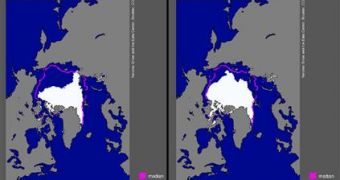By the time of our grandchildren, polar bears may be gone, like the dinosaurs. In the summer of 2007, the Arctic ice surface was about 30% under the long-term average, a record of all times. Some studies forecast ice-free Arctic summers by 2040.
Ignatius Rigor, a University of Washington climatologist, speaking at the Alaska Forum on the Environment, said that, in the summer of 2008, the Arctic sea ice could shrink even more than its record in 2007 and it's clear that it will melt away completely.
"Global warming combined with natural cyclical changes likely will continue to push ice into the North Atlantic Ocean. The last remnants of thick, old sea ice are dispersing and the unusual weather cycles that contributed to sea ice loss last year are continuing. Formal projections of sea ice loss will be made for another month or so but all indications are that ice loss will equal or exceed last year's unless the winds turn around," said Rigor.
"New ice now covering the polar seas is not like older, thicker sea ice that once covered the region in winter. In 1989, 80 % of the ice in the Arctic was at least 10 years old. Today, only about 3 % of the ice is that old. New ice melts more quickly, and then open water absorbs more sunlight, warming the seas and making the fall freeze-up come even later. It's hard to see how the system may come back," he added.
An ice-free Arctic could translate into a boom in shipping through the Bering Strait, but polar bears and other Arctic species are doomed.
"Polar bears prefer ice over the shallow continental shelf north of Alaska because it supports a rich food chain. With melting last summer, some Alaska bears were on ice as much as 600 miles (960 km) north of Barrow, far from their preferred habitat," said Steve Amstrup, a leading polar bear biologist with the U.S. Geological Survey, who forecasts that by 2050, the Alaskan polar bears will be gone due to the global warming.
The state of Alaska and others say that the forecasts of the disappearing sea ice are too speculative, while researchers signal that all forecasts have been too cautious so far, and nobody foresaw the ice loss of 2007.
"5 of the 10 studies we used projected more sea ice at mid-century than we had this summer," Amstrup said. Global warming is one factor, but a natural Arctic oscillation could be involved too.
"When the Arctic oscillation is in a "high" cycle, as it has been recently, more ice is pushed past Greenland into the North Atlantic. Climate models have linked a higher Arctic oscillation to increases in greenhouse gases, but that relationship is the subject of much study. All these changes are very consistent with a climate system trying to cool itself off from greenhouse gases," said Rigor.

 14 DAY TRIAL //
14 DAY TRIAL //